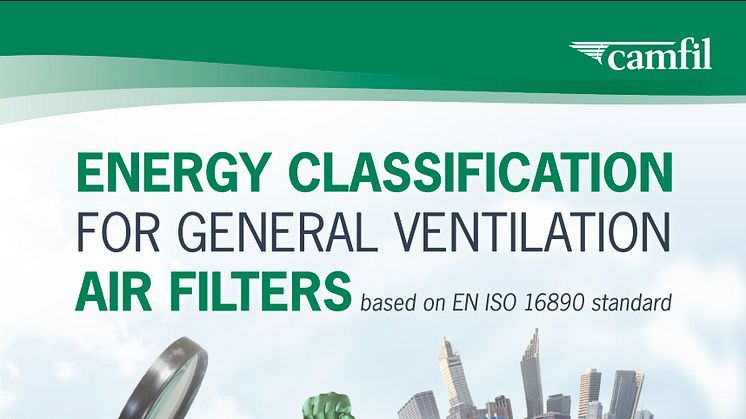
Press release -
2019 Marks a New Class of Filter Efficiency
Leading filter manufacturer, Camfil, welcomes the new classification for air filter energy efficiency introduced by Eurovent. The Eurovent Energy Rating 2019, which came into force on January 1st, is based on ISO 16890:2016, the international standard for particle filtration in buildings that replaced previous test standards on June 1, 2018.
Under the new Eurovent classification, the demands on energy efficiencies have increased, meaning many filters previously considered A+ have been downgraded to A, forcing manufacturers to improve the performance of their filters and acknowledging the general developments within the industry since the original Energy Rating was introduced in 2015.
All air filters can be graded from A+ to E. Grade A+ stands for the lowest energy consumption and E for the highest. The classification will give customers a better understanding of the annual energy consumption, average efficiency and minimum efficiency
“The energy consumption of air filters in general ventilation systems has become the focus of attention as energy prices increase, and demands to reduce CO2 emissions get tougher, not to mention our increased understanding of the effect of ‘bad air’ on our health and wellbeing,” said Tobias Zimmer of Camfil, who worked with Eurovent to develop the new classification.
“By classifying the air filters based on Eurovent’s new test standard, meeting these challenges will be more straightforward, helping specifiers, building and facilities managers save money and maintain healthy indoor air quality,” Zimmer said.
The new Eurovent Classification is defined in Rating Standard RS4/C/001-2019 and covers all products in the scope of the Eurovent Certified Performance programme for Air Filters rated at 0.944 m3/s as nominal airflow.
Based on a robust certification process, Eurovent certified products must show Annual Energy Consumption (kWh/y) specific to each ISO efficiency rating and be tested in independent laboratories and through sampling on manufacturers sites. This certified data is available to view at the Eurovent website: www.eurovent-certification.com.
Why does the ISO 16890 change everything?
There are certain, main differences between EN779:2012 and EN ISO 16890:2016
| EN779:2012 | EN ISO 16890:2016 |
| Efficiency based on one particle size, 0.4 µm | ePMx – efficiency of particle fractions with a diameter ≥ 0,3 µm and x µm |
| Dust feeding and particle efficiency measure steps up to 450 Pa final pressure drop gives average efficiency ex. 85% | Average efficiency equals average value of initial efficiency and discharged (conditioned) efficiency |
| Minimum Efficiency (ME) defines the filter in classes F7-F9. Ex: ≥ 35% is class F7 | Final pressure drop: 200 Pa (coarse) and 300 Pa (ePMx) |
| Discharging of a piece of filter-media in IPA-liquid (Isopropanol), class F7-F9 | Discharge of complete filter in IPA-vapor |
| Test dust: ASHRAE | Test dust: ISO A2/AC Fine (≈ double dust holding in grams) |
| Air flow rate: 3400 m3/h (0.944 m3/s) | Air flow rate: 3400 m3/h (0.944 m3/s) |
| No relation to real environment | More equal to real environment |
For more information regarding the Eurovent standard and Camfil’s cooperation, visit our website.
Topics
Categories
For more than half a century, Camfil has been helping people breathe cleaner air. As a leading manufacturer of premium clean air solutions, we provide commercial and industrial systems for air filtration and air pollution control that improve worker and equipment productivity, minimize energy use, and benefit human health and the environment. We firmly believe that the best solutions for our customers are the best solutions for our planet, too. That’s why every step of the way – from design to delivery and across the product life cycle – we consider the impact of what we do on people and on the world around us. Through a fresh approach to problem-solving, innovative design, precise process control and a strong customer focus we aim to conserve more, use less and find better ways – so we can all breathe easier.
The Camfil Group is headquartered in Stockholm, Sweden, and has 28 manufacturing sites, six R&D centres, local sales offices in 26 countries, and 4,180 employees and growing. We proudly serve and support customers in a wide variety of industries and in communities across the world. To discover how Camfil can help you to protect people, processes and the environment, visit us at www.camfil.com.



